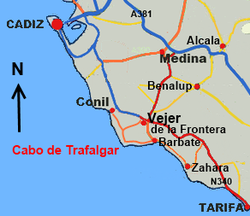
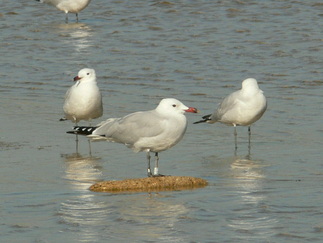
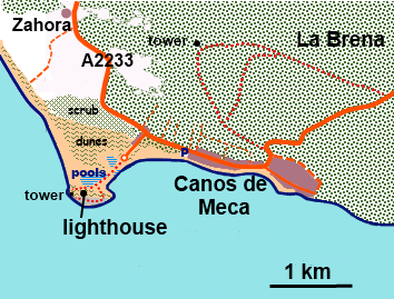
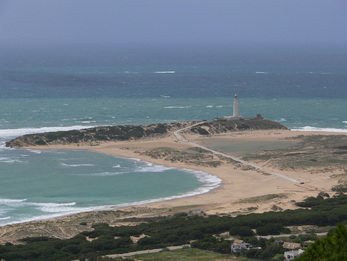
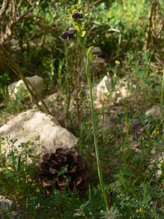
| Birding Cadiz Province |
|
 To British ears there can be few place names so redolent of past naval glories as Trafalgar nor one quite so British in celebrating victory in the midst of tragedy. Cabo de Trafalgar was one of the few historic sites that, back in the late 1960s, I managed to visit on my first trip to Spain. This was somewhat ironic since there wasn’t actually anything to see there! The Spanish, of course, were on the losing side in that battle albeit not entirely willingly so. Rather sportingly, though, in 2005 they erected a small monument there to mark the bicentenary of the battle. Naturally my ornitho-philistine friends only allowed me to visit the site because there was a chance of some good birds – principally Cory’s Shearwater and Audouin’s Gull. Unfortunately, it was a scorching hot August day, the sea was flat calm and sharing one ‘scope between five wasn’t exactly ideal so we dipped on both species. It took me over 15 years to catch up with Cory’s Shearwater (in Cornwall) and another twenty to see Audouin’s!  Cabo de Trafalgar doesn't project that far into the sea and is no great height, but situated on a 'corner' (see map) it can be good for seabirds and visible migration. Having failed so miserably previously, on my returm a few years ago I was pleased to find a large flock of gulls loafing in the shallow sandy, tidal pools beside the tombola linking the rocky cape to the mainland. A quick scan with the binoculars quickly revealed a small number of remarkably handsome Audouin’s. Whilst I hadn’t been too worried about ID issues, I was surprised by how striking the adults were with bold yellow-tipped, black banded dark scarlet bills, pale grey backs and delicate pale ashy underparts. The juveniles were less distinctive, but clearly duskier than similar species. Since then, except when they are dry or too disturbed by tourists, I have found these pools a good place to see the species. There’s usually a supporting cast of Mediterranean Gulls, Kentish Plover, Sanderling and whatever waders might be passing.  Unfortunately, I’ve not often visited the area in late September/October, but when I have I have witnessed the most extraordinary ‘visible migration’. ‘Vis. mig.-ing’ is not something I’ve always enjoyed in the UK. A good session, as often as not, means it’s windy, chilly or both and birds often fly over fast and high. Hence a good knowledge of calls is often being vital for accurate ID. In Spain birds can still go over at height and calls can mystify even more, but at least it’s often warm and dry. Standing by the lighthouse as wave after wave of larks, finches, pipits & finches pass overhead is an extraordinary experience. It can also be somewhat surprising one as seeing birds like Chaffinches and Siskins passing over isn’t the expected Mediterranean experience. Hirundines frequently not so much ‘pass over’ as skirt round you with more familiar fare being supplemented by Red-rumped Swallows and Crag Martins – many at arm’s length. Whilst not an ideal place to look for raptor migration even the dullest ‘seawatch’ here can be enlivened by the arrival of wind blown Black or White Storks, Lesser Kestrels, harriers or eagles. (Departing broad winged birds are more circumspect about leaving Europe here).  Seawatching, arguably, has the most potential for the unexpected here. Trafalgar is a somewhat blunt projection into the Bay of Cadiz, but a less public one than offered by Cadiz itself or Chipiona to the north. Watching here can be rather exposed although the old watch tower may offer some shelter in the right conditions. Watching from a car off Conil, where there are plenty of places to pull off or even grab a coffee, may be more sheltered and convenient, but the lack height and that extra ‘projection may make some difference. So it’s Trafalgar that I’ve most often gone for seabirds despite the lack of shelter. Gannets, Balearic and Cory’s Shearwaters are regular, but it may require a sharper eye than mine to pick out Yelkouan or Scopoli’s Shearwater. The latter may even require access to a small boat and SLR camera! Great Skua are also regular, but with ‘southern’ members of this complex being found off Senegal and elsewhere this is another area where a boat trip, supported by digital photography, may be needed. Arctic Skua (which I’ve seen) and presumably Pomerine Skua (which I’ve not) are probably regular here. Given that ‘seawatching’ doesn’t seem a popular branch of birding in Spain and some of the more surprising revelations made by its popularity in the UK, I wonder what surprises may be in store if an enterprising team watched Trafalgar in ideal conditions (and what are they?). The recent discovery of small numbers of Wilson’s Petrel in the Straits of Gibraltar in late summer may suggest they could be seen here in strong westerly gales. Perhaps even Bulwer’s Petrel or Little Shearwater can’t be discounted as outside possibilities in the right circumstances.  Beyond Canos de Mecca towards Barbate stand the pinewoods of La Brena. Birdlife in these woods is a little sparse (though good for Serin, Short-toed Treecreeper, etc) and, in season, migrants. However, in early spring (February onwards) the woods may have huge numbers of orchids – mainly (perhaps exclusively) Ophrys or ‘bee orchids’. To be honest I know little about orchids so my identification may be awry with some. I’m confident that many are Mirror Orchids and that some, far fewer in number, are Sombre Bee Orchids. The remainder more closely resemble ‘our’ Bee Orchid in the UK, and some indeed may be that species, but I’ve tentatively identified them as Sawfly Orchid. Sadly the nearby cliffs are no longer home to cliff nesting egrets. Yet Cabo de Trafalgar doesn’t always offer some sort of birding idyll. The conditions that create the best vis. mig. also attracts half a dozen or more bird trappers to the scrub to the north. Meanwhile the local authorities seem bent on doing their utmost to discourage visitors. It was once possible to drive just beyond the small roundabout (see map) to park along the track within a few hundred metres of the lighthouse. However, this was stopped a few years ago. For a while it remained possible to park off the road just after the turning off the A2233. However, wooden bollards have now mushroomed up here and parking is now limited to private car parks serving several small restaurants. Worse, parking off the A2233 itself now seems discouraged so you might be faced with a trek of a kilometre or more to get to the headland. Quite why the local police are so keen to stop parking here I’m unsure. However, I suspect that it might be something to do with a conflict between those who want the area’s ‘hippy’ image to continue and those who want to develop a couple of large hotels in the area and drive the place up market.
1 Comment
29/8/2018 06:27:53 am
Hi John,
Reply
Leave a Reply. |
About me ...Hi I'm John Cantelo. I've been birding seriously since the 1960s when I met up with some like minded folks (all of us are still birding!) at Taunton's School in Southampton. I have lived in Kent , where I taught History and Sociology, since the late 1970s. In that time I've served on the committees of both my local RSPB group and the county ornithological society (KOS). I have also worked as a part-time field teacher for the RSPB at Dungeness. Having retired I now spend as much time as possible in Alcala de los Gazules in SW Spain. When I'm not birding I edit books for the Crossbill Guides series. CategoriesArchives
May 2023
|